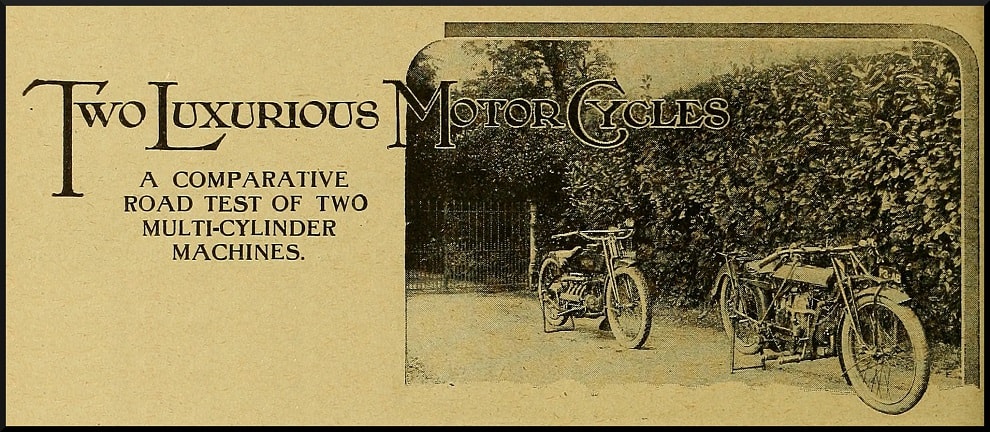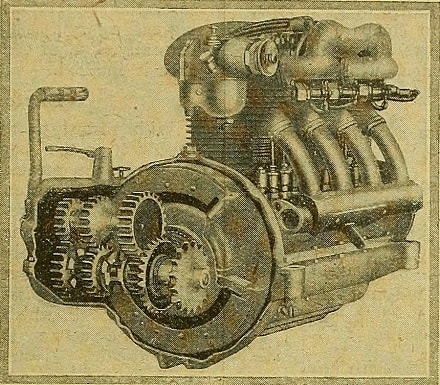
Two distinctive machines on the road - a four cylinder Henderson and 3½ h.p. A.B.C.
We have recently been able to sample one of the few 1916 model 8-10 h.p. Henderson at present in this country. It is just a year since we last described the running of the 1915 model of this machine, and very well pleased we were with it. Although the present engine has a cubical capacity of 978, and the cubical capacity of last year's model was 1,065, we cannot say that we noticed any difference in power.
It may be gathered from a reference to our description of the machine, which appeared on page 470 of the issue of May 18th, 1916, that the chief improvements of the 1916 model over the 1915 were in points of convenience. We were especially struck by the very convenient clutch control now fitted, which could be operated either by hand or foot. Personally we should prefer the hand control of the clutch to be effected from the handle-bar, whereas actually it is carried out by the usual American practice by means of a side lever. We also much appreciated the fact that the control, as regards the pedals, followed usual car practice, the clutch pedal being on the left and the brake pedal on the right. Both clutch and brake work with commendable smoothness, the clutch, though of very small dimensions, taking up the drive with an altogether silky sweetness, yet never slipping in the slightest degree. The brake, though amply powerful, was in no degree fierce.

On the 1917 model Henderson (just introduced in the States) the chief feature is the adoption of a three-speed countershaft gear.
Flexibility and Acceleration.
The great charm of the four-cylinder Henderson is its extreme flexibility, which permits one to crawl on top speed without slipping the clutch almost walking pace. From the latter speed the engine will accelerate to almost any degree, and a wonderful acceleration it is. Up to about twenty-five miles an hour the engine is quite imperceptible, though at speeds over that there is a slight tremor, which though noticeable, is not unpleasant. A share of the credit for the ample power flexibility, and acceleration is due to the excellent Schebler automatic carburetter with which the 1916 Henderson is fitted.
All one can find fault with in the Henderson is its weight, a point not noticed when the machine is started, but one which renders it somewhat awkward to handle while wheeling it about. Another point open to improvement is the kick starter, which does not appear very strong and does not give sufficient surface for the foot. On the occasion when we took over the machine the engine started on the third kick, but it did not behave quite so well in our hands, and eventually the pin of the kick starter broke. The engine thereafter was started by-pushing the machine along with the low gear in and the clutch out, then engaging the clutch with the hand lever and quickly declutching again. In about thirty seconds the engine was hot enough to run with the air fully open, and would continue to run likewise throughout day.
In the open country the Henderson's acceleration was exhilaratingly glorious, and, although no opportunity came of letting the machine out on the road, we had a very good inkling of the speed it would attain. On hills it was a real joy to drive, and would take quite respectable gradients at a fast speed, slow down at corners, and then quickly pick 'up again asif the road were level. The excellent saddle, which properly fitted the body, hinged at its forward end and its rear end suspended on coil springs, was delightfully comfortable, and further comfort was due to the 28in. x 3in. tyres.

Power unit of the 1917 Henderson. The three-speed gear lies transversely to the plane of the machine. The crankshaft is prolonged to take the clutch and a bevel pinion, the latter engaging with the crown wheel on the mainshaft of the speed gear. The kick-starter is seen on the left.
A Comparison between Two Entirely Different Machines.
This machine was in our possession for some time, and before parting with it we were invited to try another very ambitious mount, namely, the 3½ h.p. A.B.C., the rider of which was equally keen to try the Henderson. Accordingly we set out together, he on the four-cylinder monster and we on the lighter A.B.C. The comfort of the bigger machine was due in some degree to not pumping the back tyre very hard. The difference between it and the A.B.C., which, as all the world knows, has a spring frame, was practically negligible. The reason for this, we take it, was due to the fact that the A.B.C. had an extremely uncomfortable saddle, which in no way conformed to the shape of that part of the anatomy which rested upon it. The A.B.C. had standard 26in. x 2½in. tyres, but the spring frame rendered the comfort of the two just about equal; still, we venture to think that had the A.B.C. had a slightly better saddle it might have scored from the point of view of comfort. It is an extraordinarily handy machine, running with comparative quietness, and possessing a degree of acceleration almost equal to that of the Henderson, if not quite, although one had perhaps to change gear occasionally to obtain it, and an absolutely vibrationless engine.
We drove the smaller machine practically all day, and no matter which of the four gears provided was in engagement no vibration could he felt from the engine at all; while the four-cylinder machine which possessed a two - speed hub produced a slight, though not altogether unpleasant, "period,' which was apparent at certain speeds.
Evenly Matched.
Of the two, perhaps the Henderson may be called the more complicated on account of the multiplicity of cylinders. The 1916 model possesses only two speeds, and these were ample on account of the power of the engine, as the low was only used for starting and once on taking the bad corner on Ranmore Common, while the A.B.C. has four, and yet so easily was the gear changed that the complexity of the four-speed box in no way detracted from, but on the contrary greatly added to, the pleasure of riding. It should be added that the 1917 Henderson has a three-speed countershaft gear box.

The four-speed horizontal twin spring frame A.B.C. On the latest models the kick-starter is enclosed.
We have referred previously to the extraordinary acceleration of the Henderson, but on the few occasions on which we tried it when running with our companion we found that the A.B.C. was not left half a length behind. As regards flexibility, the A.B.C. was almost equal to the four-cylinder, and there is no doubt that it is a wonderfully efficient machine, as our contributor " Road Rider" has stated.
An Interesting Day.
A curious fact seas noticed on letting down the A.B.C. from the stand. Instead of the back wheel dropping with a thump, as happens with an unsprung machine, it came down with a curious cushioning effect only experienced on motor bicycles when the back tyre is half flat.
From the point of view of brakes there is very little to choose between the machines. The A.B.C. was fitted with two side-by-side internal expanding brakes which have recently been described in The Motor Cycle.
Altogether the day was a most interesting one, as it is very rare for us to have the opportunity of testing two machines which probably show more originality in design and a greater divergence in construction than any other pair which could be selected in this or any other country. These models represent the British and American designers' ideas of a luxurious two-wheeled motor cycle, so ambitious that they are devoid of no refinement obtainable in a car. Moreover, they are thoroughly sporting mounts, having such a turn of speed as would enable them to leave any but the best cars far in the rear.
RI
From "The MotorCycle" - October 19th, 1916
